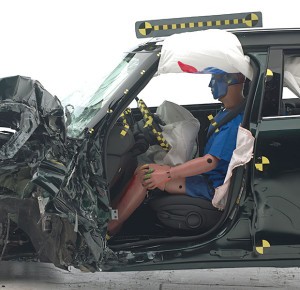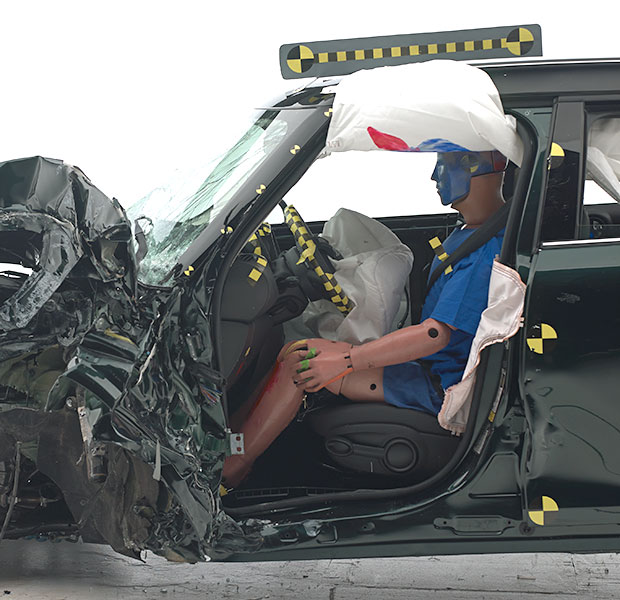The Mini Cooper Countryman is the only small car to earn a good rating among the latest group of 12 cars subjected to the insurance industry’s small overlap front crash test.

Two electric models and a hybrid also are in the mix, with varied results, according to the Insurance Institute for Highway Safety.
The electric-powered Chevrolet Volt (with a gasoline engine “range extender”) earns an acceptable rating, while its battery-electric rival, the Nissan Leaf, earns a poor rating. The Ford C-Max Hybrid, a small four-door wagon, earns an acceptable rating. Another small four-door wagon, the gasoline-powered Mazda 5, is rated poor.
Five small cars, all 2014 models, earn an acceptable rating, two earn marginal and four earn poor ratings for occupant protection in a small overlap crash in the Institute’s latest round of evaluations. The Institute now has evaluated 32 small cars for small overlap front crash protection. Of them, 19 earn a good or acceptable rating and 13 earn marginal or poor.
Mid-Size SUV Front Crash Test Results
Introduced in 2012, the small overlap test replicates what happens when the front corner of a vehicle collides with another vehicle or an object such as a tree or utility pole. In the test, 25 percent of a vehicle’s front end on the driver’s side strikes a rigid barrier at 40 mph. IIHS said the test is more difficult than either the head-on crashes conducted by the National Highway Traffic Safety Administration or the IIHS moderate overlap test. In the small overlap test, the main structures of the vehicle’s front-end crush zone are bypassed, making it hard for the vehicle to manage crash energy. The occupant compartment can collapse as a result.
“The Mini Cooper Countryman gave a solid performance,” said Joe Nolan, the Institute’s senior vice president for vehicle research. “The Countryman’s safety cage held up reasonably well. The safety belts and airbags worked together to control the test dummy’s movement, and injury measures indicate a low risk of any significant injuries in a real-world crash this severe.”
The Countryman, introduced in 2011, is a larger four-door version of the two-door Mini Cooper. The small overlap rating for the Countryman doesn’t apply to the two-door model, which hasn’t been tested.
To earn the top rating of good, automakers need to focus on overall crash protection. That means an occupant compartment that resists intrusion, safety belts that prevent a driver from pitching too far forward and side curtain airbags that provide enough forward coverage to cushion a head at risk of hitting the dashboard or window frame or things outside the vehicle. Collapsing structures can knock front airbags and seats out of position, exacerbating the problem.
IIHS Videos Provide Behind the Scenes Look at Crash Test Dummies
“Collapse of the occupant compartment is the downfall for four small cars in this group, including the Fiat 500L, Mazda 5, Nissan Juke and Nissan Leaf,” Nolan said. “A sturdy occupant compartment allows the restraint systems to do their job, absorbing energy and controlling occupant motion.”
In the Fiat 500L, a four-door variant of the much smaller Fiat 500 coupe, intruding structure seriously compromised the driver’s survival space, knocking the steering wheel back and to the right of the driver. The Fiat 500L (and 500) earns a poor rating for small overlap front crash protection.
The Mazda 5 shares the distinction with two other cars of being the worst-performing models the Institute has evaluated in the small overlap test. The other two are the 2014 Kia Forte, a small car, and the 2012 Prius v, a midsize hybrid.
“When we tested the Mazda 5 we saw a host of structural and restraint system problems. Parts of the occupant compartment essentially buckled, allowing way too much intrusion,” Nolan said.
The Mazda 5 also is distinct in that it is the only vehicle in this group to earn a marginal rating in one of the Institute’s other four evaluations — moderate overlap front, side, rollover and rear. The Mazda 5 earns a marginal rating in the side impact test. That also makes it the only 2014-model car the Institute has evaluated to earn anything less than acceptable in the side test. Most models earn a good rating.
Volt and Leaf Electrics
Back in 2011, the Volt and Leaf were the first mainstream plug-in electric models to undergo IIHS crash test evaluations. The 2011 models earned top ratings in the moderate overlap front, side, head restraint and roof-strength evaluations. That’s still the case with the 2014 versions of both cars.
“Electric vehicles have a unique challenge in the small overlap test because of their heavy batteries. The Volt performed reasonably well, earning an acceptable rating, while the Leaf struggled,” Nolan says.
Driver space in the Volt was maintained reasonably well in the test, and injury measures taken from the dummy indicate a low risk of any significant injuries to a person in a similar crash. In the Leaf, the dummy had a different experience. The Leaf chalked up as much as 16 inches of intrusion in the lower occupant compartment and 14 inches in the upper occupant compartment. The instrument panel, parking brake pedal and steering column were all pushed back toward the driver. Injuries to the left knee and left lower leg would be likely in a crash of this severity, and injuries to the left thigh would be possible.
Award Winners
The Volt, which has a basic-rated optional forward collision warning system, is the only car in this test group to earn a 2014 Top Safety Pick+ award. The C-Max Hybrid, Countryman, Mitsubishi Lancer, and the Scion FR-S and its twin the Subaru BRZ qualify for Top Safety Pick, the Institute’s second-highest award. These models miss the “plus” award because they don’t have an available front crash prevention system.
To qualify for Top Safety Pick+, a vehicle must earn a good or acceptable rating for small overlap protection, a good rating in the Institute’s other four tests, and a basic, advanced or superior rating for front crash prevention. To qualify for Top Safety Pick, a vehicle must earn a good or acceptable rating for small overlap protection and a good rating in the other four tests.
“Consumers in the market for a small car now have six models to consider on our list of 2014 Top Safety Pick+ award winners, and an additional 13 that earn Top Safety Pick,” Nolan said. “Consumers trading the inherent safety of a larger vehicle for the convenience or fuel economy of a small car should focus their search on these vehicles with state-of-the-art safety designs.”
Source: Insurance Institute for Highway Safety
Was this article valuable?
Here are more articles you may enjoy.


 Apollo Expands Asset-Level Risk Reviews to Reflect Impact of Extreme Weather
Apollo Expands Asset-Level Risk Reviews to Reflect Impact of Extreme Weather  Twice Injured Firefighter Loses Second Workers’ Compensation Claim
Twice Injured Firefighter Loses Second Workers’ Compensation Claim  Flooding in California Leads to Soaked Roads, Water Rescues and 1 Death
Flooding in California Leads to Soaked Roads, Water Rescues and 1 Death  LA Fires Push Insurers’ 2025 Disaster Losses to $107 Billion
LA Fires Push Insurers’ 2025 Disaster Losses to $107 Billion 